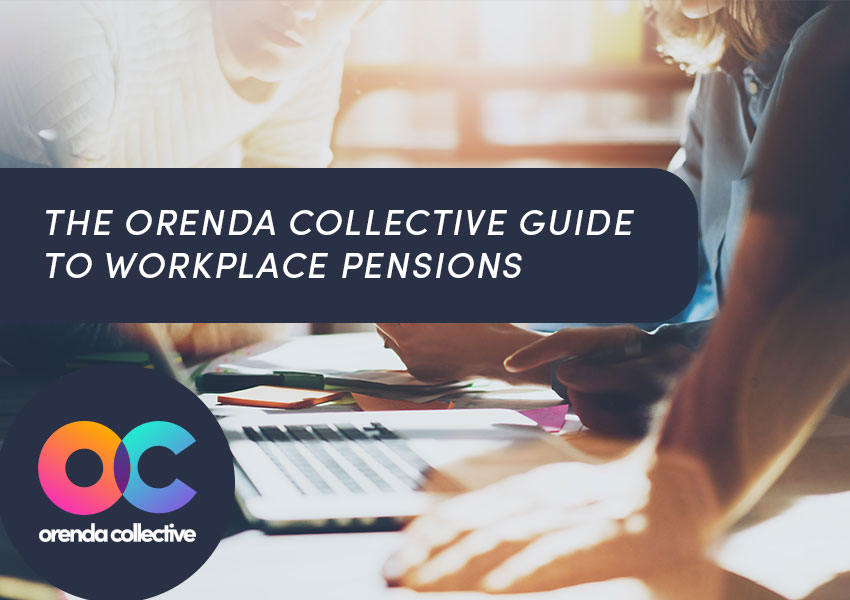
What is a workplace pension?
A workplace pension is a way of allowing an employee to save for their retirement that’s arranged by the employer.
Some workplace pensions are called ‘occupational’, ‘works’, ‘company’ or ‘work-based’ pensions.
Under the Pensions Act 2008, every employer in the UK must put certain staff into a workplace pension scheme and contribute towards it. This is called ‘automatic enrolment’. If you employ at least one person you are an employer and you have certain legal duties.
How do workplace pensions work?
A percentage of your employee’s pay is put into the pension scheme automatically every payday.
In most cases, the employer adds money into the pension scheme too. The employee may also get tax relief from the government.
Does Auto-enrolment apply to my business?
Whether you’re a coach, a graphic designer, have a marketing business, or a photographer, you are an employer from the day your first member of staff started working for you and you have legal duties.
If you are employing staff for the first time, your legal duties for automatic enrolment begin on the day your first member of staff starts work. This is known as your duties start date. You should start preparing early in anticipation of this, so you know what you’ll need to do.
Does my business have to operate a workplace pension?
All employers must provide a workplace pension scheme. This is called ‘automatic enrolment’.
Employers must automatically enrol employees into a pension scheme and make contributions to the pension if all of the following apply:
- They are classed as a ‘worker’
- They are aged between 22 and State Pension age
- They earn at least £10,000 per year
- They usually (‘ordinarily’) work in the UK (read the detailed guidance if you’re not sure)
Are there any situations when my business does not have to operate a workplace pension?
The employer usually does not have to automatically enrol a worker if they do not meet the previous criteria noted above or if any of the following apply:
- They’ve already given notice to you that they’re leaving their job, or you’ve given them notice
- They have evidence of their lifetime allowance protection (for example, a certificate from HMRC)
- You have already included the worker on a pension that meets the automatic enrolment rules and you the employer arranged it
- You made a one-off payment to a workplace pension scheme that’s closed (a ‘winding-up lump sum’), and then the worker leaves and re-joins the same job within 12 months of getting the payment
- more than 12 months before the staging date, the worker left (‘opted out’) of a pension arranged by your employer
- The worker is from an EU member state and they are in an EU cross-border pension scheme
- The worker is in a limited liability partnership
- The worker is a director without an employment contract and employs at least one other person in your company
Does my business have to contribute to a workplace pension for my employees?
An employer does not have to contribute to an employee’s pension if they earn these amounts or less:
- £520 a month
- £120 a week
- £480 over 4 weeks
If an employee earns less than £10,000, but above £6,240, the employer doesn’t have to automatically enrol the employee in their scheme however, if they join, the employer will be unable to refuse you and must make contributions on the employees behalf.
Do I need to auto-enrol my employees?
What you need to do will depend on whether you’re about to start your automatic enrolment duties or whether you’re coming back for re-enrolment.
The pension regulator has a useful Q&A tool that will help you determine when and if you need to auto-enrol your employees that we recommend you use, but below is a useful summary.
| Type of employee | Eligible jobholder | Non-eligible jobholder | Entitled worker |
| Age | 22-State Pension age | 16-74 | 16-74 |
| Earns | £10,000+ | £6,240-£10,000 | Below £6,240 |
| Auto enrolment status | Must be auto enrolled | Can ask to join | Can ask to join |
| Employer contribution status | Employer contributions required | Employer contributions required | Employer contributions are required in line with our Scheme rules. |
- You’re only required to auto enrol eligible jobholders. You must pay contributions towards their pension savings. You must enrol eligible jobholders even if they say they don’t want to join the Scheme.
- Non-eligible jobholders can ask to join the Scheme. If they ask, you must put them in and pay contributions towards their pension savings.
- Unless you have alternative pension arrangements for entitled workers, they can also ask to join the Scheme and you must put them in.
What does my business have to tell an employee when they are auto-enrolled?
The business must write to the employee when they’ve been automatically enrolled into the workplace pension scheme. You must tell them:
- the date you added them to the pension scheme
- the type of pension scheme and who runs it
- how much they’ll have to pay in and how much you’ll contribute
- how to leave the scheme, if they want to
- how tax relief applies to them
So you have established you need to auto-enrol your employees, what next?
Your automatic enrolment duties start when you employ your first member of staff (duties start date).
You have 6 weeks from your duties start date to set up a pension scheme.
Step by step guide to fulfil your duties:
- Choose a pension scheme: Choose a pension scheme that can be used for automatic enrolment and put your staff into it. Do this as soon as possible as it may take time.
- Work out who to put into a pension scheme: Work out who you need to put into a pension scheme on your duties start date. Do this on your duties start date.
- Write to your staff: Use the pension regulator letter templates to write to each member of staff individually to tell them how automatic enrolment applies to them. Do this within 6 weeks after your duties start date.
- Declare your compliance: Use the pension regulator declaration of compliance checklist to find out what information you’ll need to provide to them how you’ve met your duties. You must complete your declaration by your deadline or you may be fined. Do this within 5 months after your duties start date
How much has to be contributed to the auto-enrolment pension scheme?
Any worker who earns over the lower threshold for qualifying earnings is called a jobholder. You’ll have to make a minimum contribution into their retirement pot.
Workers earning less than the lower threshold of qualifying earnings are called ‘entitled workers’ or ‘workers without qualifying earnings’. For these workers, you don’t have to make a minimum contribution, but you can if you want to.
There are several ways you can calculate contributions for auto enrolment. There are statutory minimum contribution levels, but you can choose to set higher contribution levels if you want to.
Qualifying earnings
This is the minimum basis for calculating auto enrolment pension contributions.
Basic earnings
These include basic pay, holiday pay, and statutory pay such as sick pay or parental leave pay. They don’t include bonuses, commission, overtime, and similar payments.
If you use basic earnings to calculate auto enrolment pension contributions, the minimum contribution to an employee’s pension savings is 9%. Employers must pay at least 4% and the employee the remaining 5%.
Total earnings
These are all earnings including basic pay, holiday pay, sick pay, bonuses, commission, overtime and similar payments. If you use total earnings to calculate auto enrolment pension contributions, the minimum contribution to an employee’s pension savings is 7%. Employers must pay at least 3% and the employee the remaining 4%.
These are all earnings including basic pay, holiday pay, sick pay, bonuses, commission, overtime and similar payments. If you use total earnings to calculate auto enrolment pension contributions, the minimum contribution to an employee’s pension savings is 7%. Employers must pay at least 3% and the employee the remaining 4%.
| Definition | Qualifying earnings | Basic earnings | Total earnings |
| Includes | All earnings between a lower and upper limit set by the government and reviewed each year. | Basic pay, holiday pay and statutory pay such as sick pay, but not bonuses, commission, overtime and similar payments. | All earnings including basic pay, holiday pay, sick pay, bonuses, commission, overtime and similar payments. |
| Total minimum contribution | 8% | 9% | 7% |
| Employer | 3% | 4% | 3% |
| Employee | 5% | 5% | 4% |
What are qualifying earnings?
Qualifying earnings is a band of gross annual earnings that can be used to work out what contributions a worker should get. It includes a worker’s salary, overtime, bonuses and commission, as well as statutory sick, maternity, paternity or adoption pay.
For the 2023/24 tax year it’s anything over £6,240 and up to £50,270.
How much is the minimum contribution?
The legal minimum for jobholders is currently 8 percent of their qualifying earnings. Of this, you need to pay at least 3 percent. The remainder comes from your workers’ pay, which you’ll have to collect and send to your pension provider, and tax relief from the government. The pension provider will claim the tax relief on your workers’ behalf.
You can pay more if you want to. Some employers pay all of their workers’ minimum contributions or pay additional amounts on top of the minimum. This is a good way of attracting and keeping good workers in your organisation.
The table below outlines the minimum contributions:
| Date | Minimum contribution | What you’ll pay | What your worker pays | What the government pays |
| From 6 April 2019 | 8% | 3% | 4% | 1% |
How do you work out the minimum contributions?
The minimum contribution is a percentage of a worker’s gross annual earnings that fall within the qualifying earnings band.
For the 2023/24 tax year this means that the first £6,240 of their earnings isn’t included in the calculation. For example, if a worker earned £20,000 in 2023/24 their qualifying earnings would be £13,864 and their annual minimum contribution would be based on that.
Because you pay contributions every time you pay your workers, you’ll need to work out qualifying earnings for each pay period and make your contribution based on these amounts. There may be pay periods when workers don’t earn enough to qualify for a minimum contribution.
The table below shows the lower and upper levels of qualifying earnings for some commonly-used pay periods. You’ll need to make a contribution based on everything they’re paid over the lower level and up to the upper level.
| Pay period | Lower Level of qualifying earnings | Upper level of qualifying earnings |
| Weekly | £120 | £967 |
| Fortnightly | £240 | £1,934 |
| Four-weekly | £480 | £3,867 |
| Monthly | £520 | £4,189 |
What is the duties start date?
Your legal duties for automatic enrolment begin on the day your first member of staff starts work. This is known as your duties start date and you cannot change this date.
Can I use postponement?
One of the main reasons you might decide to delay working out who to put into a pension scheme is if you have seasonal or temporary staff who you know will stop working for you within three months. You can also use it for staff who begin work on a probationary period or if you need more time to set up your pension scheme or other business processes. But you can choose to use postponement for any other business reason.
When you can postpone?
You can only postpone automatic enrolment from:
- your duties start date
- a staff member’s first day of employment
- the date a staff member first meets the age and earnings criteria to be put into a pension scheme that you also pay into.
Remember, if you use postponement on your duties start date it only changes the day on which you need to assess your staff, it doesn’t change your duties start date or your declaration of compliance deadline. You can only use postponement if you’re within six weeks of the date that your member of staff met the age and earnings criteria to be put into a pension scheme.
How do I use postponement?
You must write to each member of staff individually to tell them that you have delayed working out who to put into a scheme and how automatic enrolment applies to them. You will have six weeks to write to them from the date after postponement starts. There’s no need to tell us that you’ve decided to use postponement.
You can postpone for up to three months. You can postpone as many or as few staff as you like and the postponement period doesn’t have to be the same length for everyone.
If any of your staff write to you asking to join a pension scheme during the postponement period, you must put them into one once you have received their request.
You will have to pay into the pension scheme if they are:
- aged 16-74
- and earn at least £520 a month or £120 per week.
To find out how much you will need to pay you should ask your pension scheme provider.
Do I have any on-going duties?
Each time you pay your staff (including new starters), you must monitor their age and earnings to see if they need to be put into a pension scheme and how much you need to pay in. Find out more about your ongoing duties.
When does automatic enrolment apply to a director?
You will have automatic enrolment duties:
- if the director has a contract of employment with your organisation and at least one other person (who can be another director or a member of staff) also has a contract of employment with your organisation
- if you have multiple directors and no other staff – and at least two of the directors have employment contracts – all the directors with employment contracts will be members of staff and subject to automatic enrolment duties
When does automatic enrolment not apply to a director?
You will not have automatic enrolment duties:
- if a director does not have an employment contract, they are not considered a member of staff and do not need to be assessed for automatic enrolment – however if you have other staff, you’re an employer and will have duties for these staff – even if none of these staff meet the age and earnings criteria to be put into a pension scheme you must still complete a declaration of compliance
- if your organisation only has directors without contracts of employment and no other staff
- if your organisation only has one director with a contract of employment and no other staff
When should I reach out to an accountant?
Operating a payroll with or without auto-enrolment can be complex and time consuming. There is also a real possibility for penalties and employee disputes if the appropriate procedures are not followed.
We therefore recommend you reach out to an accountant ahead of employing any staff or paying yourself through payroll to reduce your risk.
If you need any support please do not hesitate to contact The Orenda Collective.

